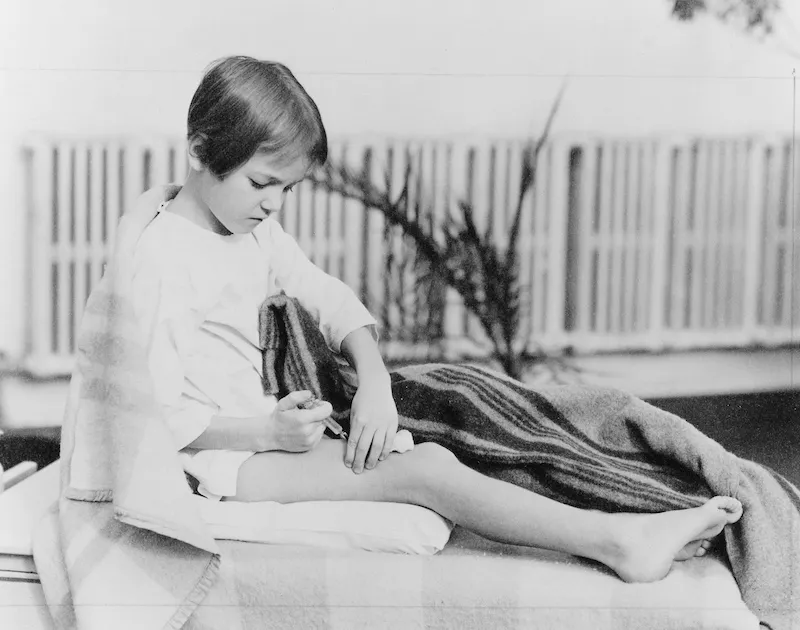Elizabeth Hughes developed type 1 diabetes in 1918. She was 11 years old and, in those days, that meant that she had a year of life.A few more if I had a good doctor and the treatment was still well.The hospitals of the time had rooms in which diabetic children, already in a coma, waited for death.
As Abigail Zuger said, from time to time we sell to hype and saucer that there is a miracle drug, a medication capable of curbing an incurable disease.Most are pure smoke, but there are some (one or two in each generation) that do get it and the first one we discovered was surely insulin.
The taste of pis
Diabetes was not a new, or unknown disease.The first written testimony dates from 1552 before Christ.But throughout history, he confused doctors, because his main symptom (polyuria; that is, urinating abundantly) pointed to a kidney problem.
Thomas Willis was the first to proved a patient's pee to verify that, indeed, he knew sweet
It was Thomas Willis who, in 1679, wet his finger in a patient's urine to discover that, that pee was sweet.He also realized that other times it was not and distinguished the two great diabetes: the Mellitus (from the Greek 'Melli' (μέλι), honey) and the tasteless.
Type 1 of diabetes mellitus is an autoimmune disease;That is, it is the body itself that attacks the cells of the pancreas that produce insulin.Having insulin that can metabolize sugar, the body has to extract the energy from fat.In the end and without insulin, the metabolization of fat ends up producing a ketoacidosis, coma and death.
a very hard treatment for a terrible disease
The only treatment at that time was a Spartan diet: caloric enough so that the body did not have to resort to fats, but light enough so that there was no excess of blood sugar (this obstructs the microcirculation and, likeconsequence, blindness or neuropathy appeared).
But the diet only managed to extend the life of the patients: in the medium term, the pancreas stopped producing insulin and, sooner rather than later, they ended up dying.It was a very hard treatment for a no less terrible disease: children who had so far been healthy and lustrous and that were gradually consumed.
the girl Elizabeth
In the case of Elizabeth, the battle was also long.The case we know him and is well documented because his father, Charles Evans Hughes, was an important guy: governor of the state of New York, secretary of state of the federal government and president of the Supreme Court of the United States.
The most effective treatment, which only extended the life of the children something else, made them consumed little by little.
The spring of 1919 began to see Dr. Frederick M. Allen in New Jersey.A treatment began that lengthened almost three years.When the girl arrived at the consultation, she weighed 34 kilos;In August 1922, it weighed only 20. It was consumed.
It was on August 15, 1922 when he arrived in Toronto to give himself from Bruces with Frederick Banting and the liquid that would give him almost 60 years of life more.
Insular issues
In 1869, Paul Langerhans, a medical student from Berlin, was watching pancreas with the microscope.It was at that time that he saw that there was a kind of lumps, small cell groups, which no one had previously paid attention.Those fabric piles, which were not yet known for what they were for, were called 'Langerhans islets'.
At the beginning of the 20th century, several teams were on the track of insulin, but the great war stopped the investigations dry
Edouard LaguesseHe proposed that the secretions of these cells could help regulate digestion and this secretion was called 'insulin' (from Latin 'Ínsula', island) by Langerhans islets.
During the last years of the 19th century, researchers discovered more and more things about insulin.At the beginning of the 20th century, we were already able to start working with her.In 1906, George Ludwing Zuelzer began treating his dogs with pancreas extract, but had to leave his job.The same happened to Ernest Scott that he was unable to convince his laboratory chief of the value of his discoveries.Israel Kleiner and Nicolae Paulescu, separately, almost managed to extract and purify it but World War I ended their plans.
a laboratory of Toronto
Interestingly, Frederick Banting, a surgeon, who found the key.A surgical technique could be used to isolate the pancreatic islets of dogs and thus be able to extract insulin.He traveled to Toronto in 1921 and, with enough effort, convinced John Macleod, professor of physiology at the University of Toronto, to let him investigate taking advantage of the fact that Macleod went to Scotland on summer vacation.
The project was a success: Banting and an assistant C. H. Best were able to keep animals without living pancreas throughout the summer.So much so that when Macleod returned from Scotland, he took over the project.Something that, in the end, enmity with Banting forever.
On January 11, 1922, Leonard Thompson, a 14 -year -old kid, became the first person to receive an insulin injection.They had been working on the purification of the extract only one month and that was noticed.Thompson suffered a terrible allergic reaction and the treatment stopped.
Luckily, they did not stop: in 12 days and with the help of James Collip, they got enough purity.The injection of January 23 was a success.By mid -1922, Eli Lilly and Company, a pharmacist, had managed to create a procedure to produce it in large quantities and very purified.
Insulin
Diabetes had not cured, but it had become chronic.Insulin ended those immense children's rooms in a coma.And only a year later the Karolinska Institute granted the Nobel to Banting and Macleod.In comparison, Fleming's for penicillin was more than 15 years after his discovery.Banting enraged, shared the award with Best and did not go to pick it up.
Elizabeth Hughes died in 1981, with about 42,000 insulin punctures behind her.Or, in this case, perhaps in another part of the body.As we said, it was not the first patient, but his fame (and his father's) made the success of insulin open the newspapers throughout America and Europe.Many experts are convinced that their case accelerated insulin penetration almost ten years, saving many lives.And that was the real miracle.



